When setting construction of euphoric and satisfying zero-carbon society as a goal, we should consider the back-casting scenario of how to reach it. To that end, it is necessary to use a simple but clear indicator of GDP and CO2 emissions without separating, economic development and decarbonization. To achieve the target below 2 degrees, technology development and diffusion (TD&D) play key role. This paper clarifies the usefulness and importance of quantitative technical evaluation that can be used for investment judgment and expansion of TD&D which practically accelerate to low carbonization and innovation in world.
Challenge
Globally common and inevitable goal for us is aiming at building a zero carbon society. It is important to consider the back-casting scenario of how to achieve it. In order to realize the zero carbon society, quantitative evaluation is indispensable.
First of all, we must respond to the questions whether targeted society is reachable from the viewpoint of economic development, and secondly, whether society can reach the goal with fewer barriers. The answer to the former can be thought of as a simple yet clear indicator of GDP and CO2 emissions. For the latter, the development and the widespread diffusion of technology are the most effective measures with less barriers. In that context, appropriate quantitative assessment of technology has an important role in investment decisions in technology development and use.
- By adequately monitoring the scale and timing of introducing the optimal low-carbon technology system will maximize lower-cost and lower-carbon opportunities.
- Usually future cost of technology in estimation models is often derived from numerical values calculated from ‘black box’. In order to make effective investment decisions, it is necessary to clarify whose basis and boundary conditions of the calculation.
- Investment opportunities are fully utilized by implementing the technology installation plan with considering development level of the country and/or region.
- To introduce low-carbon technology, it is important to clarify the spillover effects on economic, energy and environmental aspects in a whole society. It reduces the risk of being marginalized due to difficulties such as inflexible and short-term investment decisions.
Proposal
Proposal 1: To achieve the global warming target of 2 degrees or less, it is important to raise the decreasing rate of CO2 emissions per GDP. To that end, it is necessary to accelerate the technology transfer speed and to introduce appropriate technology systems through international cooperation.
Rationale
- Figure 1 shows the change in world CO2 emissions per GDP from 1850 to the present. From the Industrial Revolution to the beginning of the 1900s period, the increase due to expansion of industries with high CO2 emissions was remarkable. After the peak of 0.93 t /1000USD in 1913, there was a decrease due to changes in the industrial structure and the spread of new technologies. In the past 100 years, the average rate of reduction is 0.0047 / year, in the past 50 years it was 0.0074 / year.
- Future temperature can be estimated by using this CO2/GDP, relation of ∆T and accumulated CO2 (Matthews, 2009), and economic growth rate (Figure 2). If the rate of decrease slows down (0.0030 /yr.), The temperature rise will be 4.3 degrees in 2100, while continuing with the current reduction rate (0.0074 /yr.), the goal below 2 degrees can be achieved by reducing the annual carbon emissions to zero by 2074.
- Figure 3 shows the relationship between population and GDP growth rate of seven developed countries (upper two figures) and regions (lower). When the growth rate of the population is high, GDP growth rate tends to be high. In developed countries, the economic growth rate in recent years has declined. On the other hand, in developing countries the population growth rate has slowed somewhat, but the economic growth rate is high (1). By innovation for decarbonization leading to these economic growth and introduction of new systems, we must induce leapfrogging of the development of developing countries. In these countries, infrastructure is not ready and should be newly installed. In other words, there will be advantage of being easy to introduce the state of art equipment/facility. Therefore, compared with developed countries, investment for decarbonizing society is more efficient, effects appear earlier.
Suggestions on means to implement
- By increasing the reduction rate of CO2 emissions per GDP, it is possible to approach the goal of 2 degrees or less. To this end, mechanism and framework will be significant that raises GDP by reducing CO2, e.g., technology development and deployment.
- As the population decreases, it is important how quickly to decrease GHG emissions, and it is necessary to look at both economy and environment. To that end, it is important to link technological progress and economy and accelerate technology transfer between countries/regions.
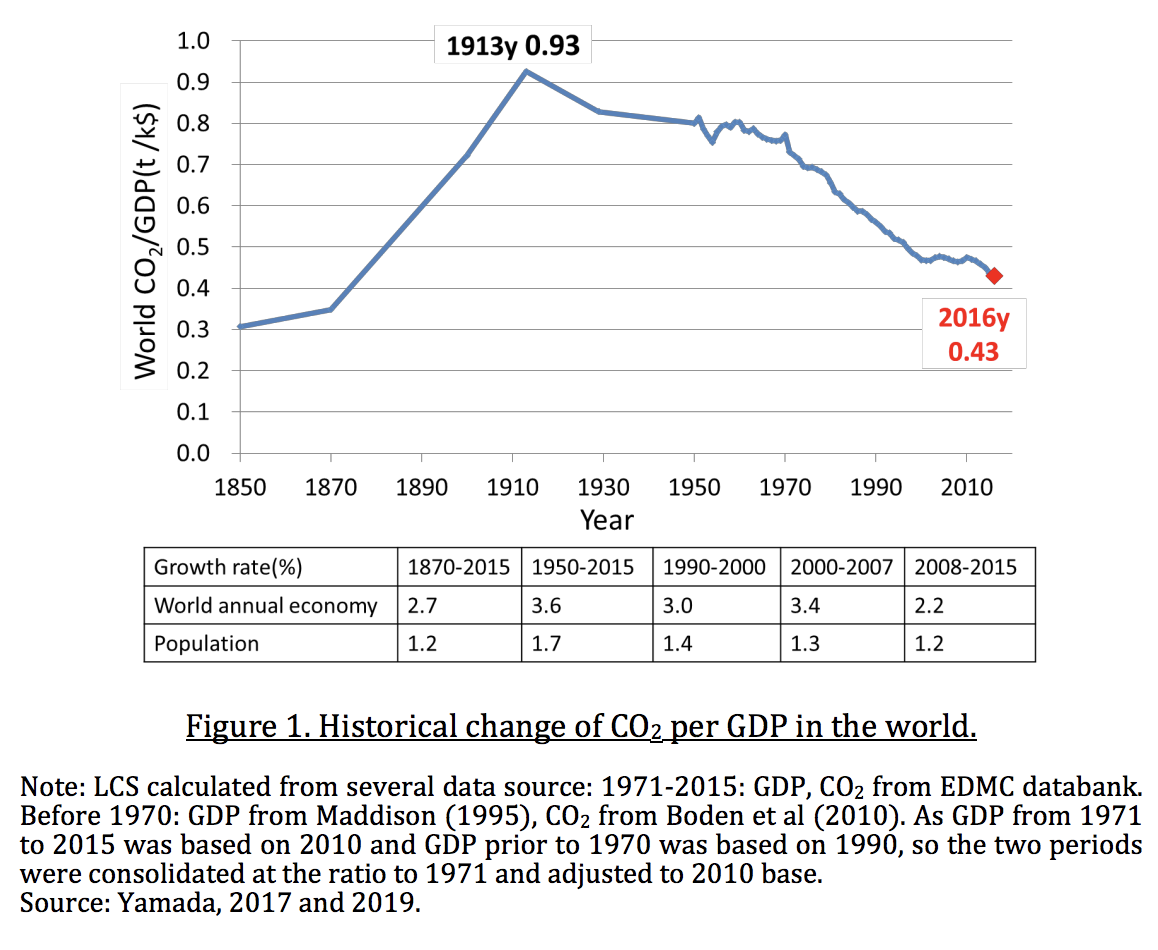
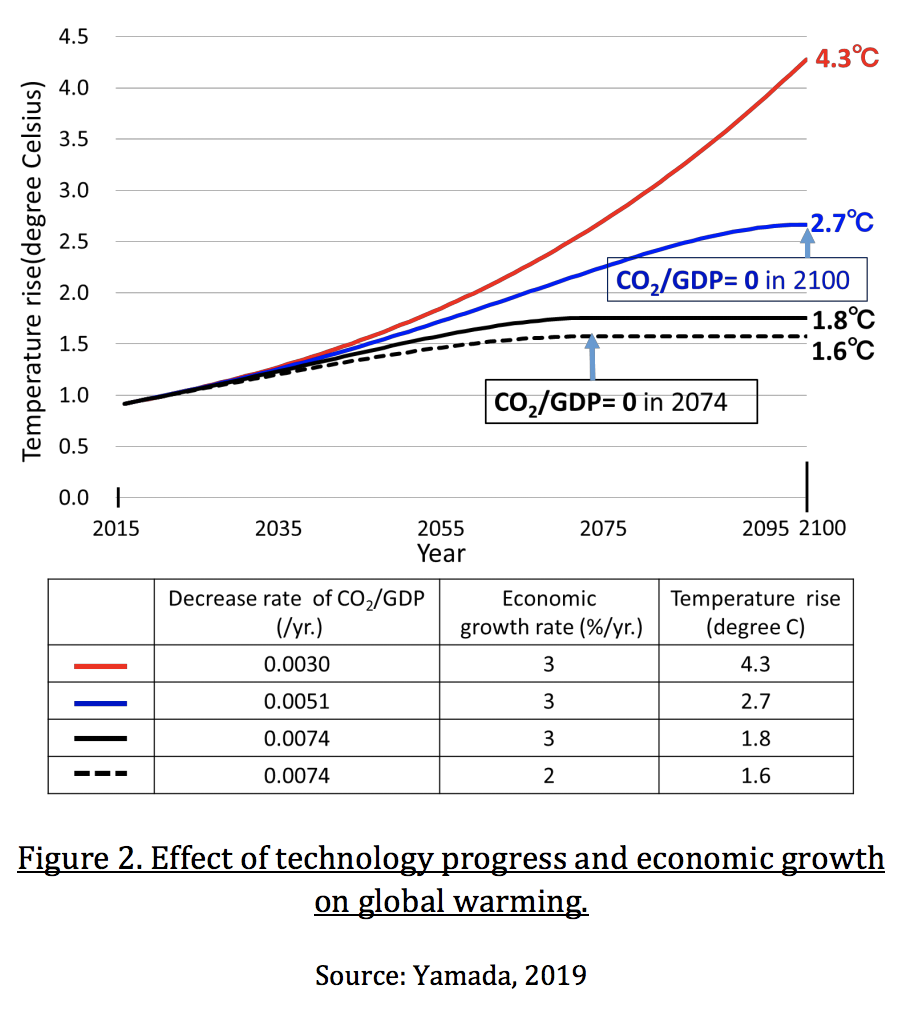
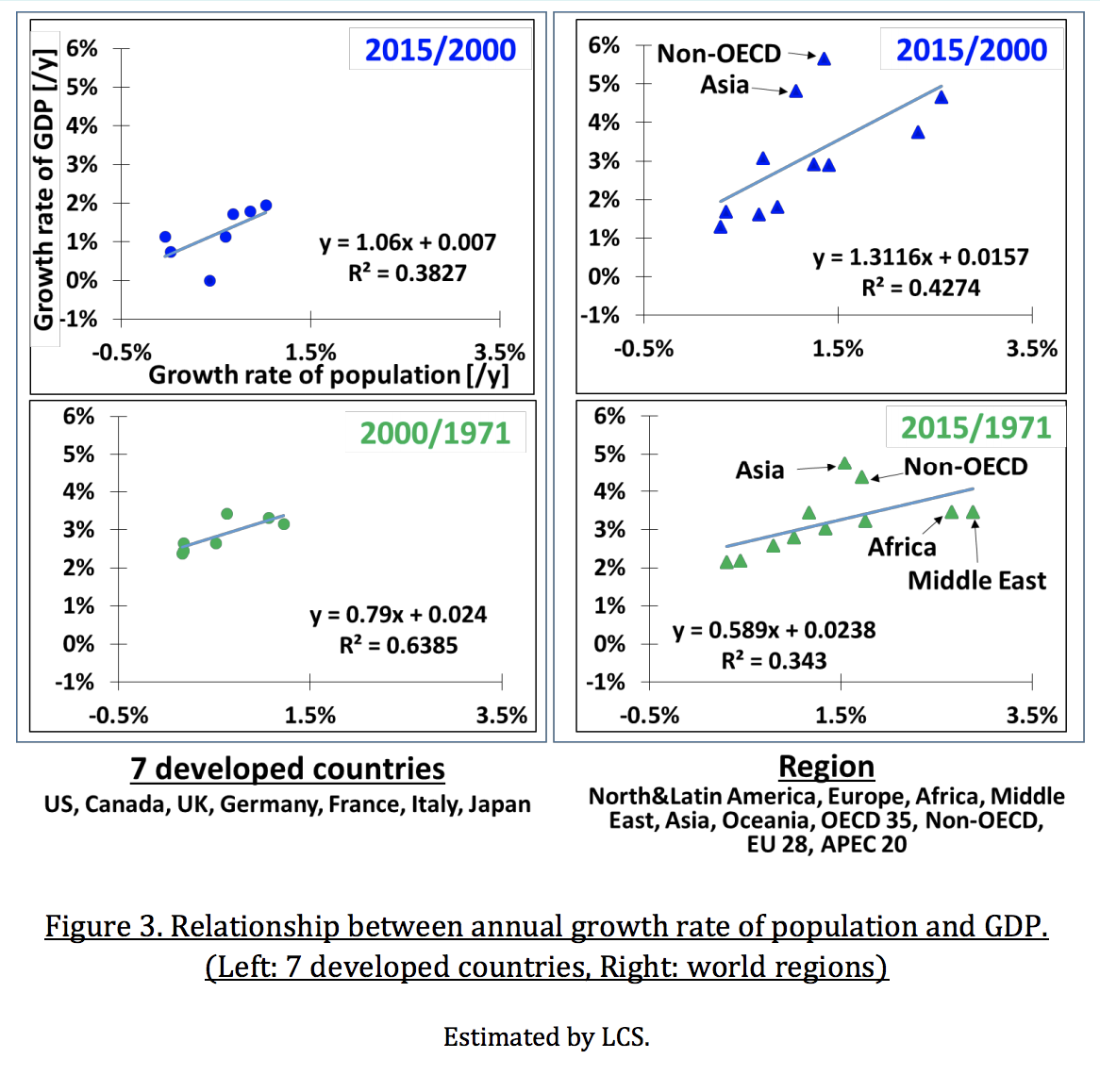
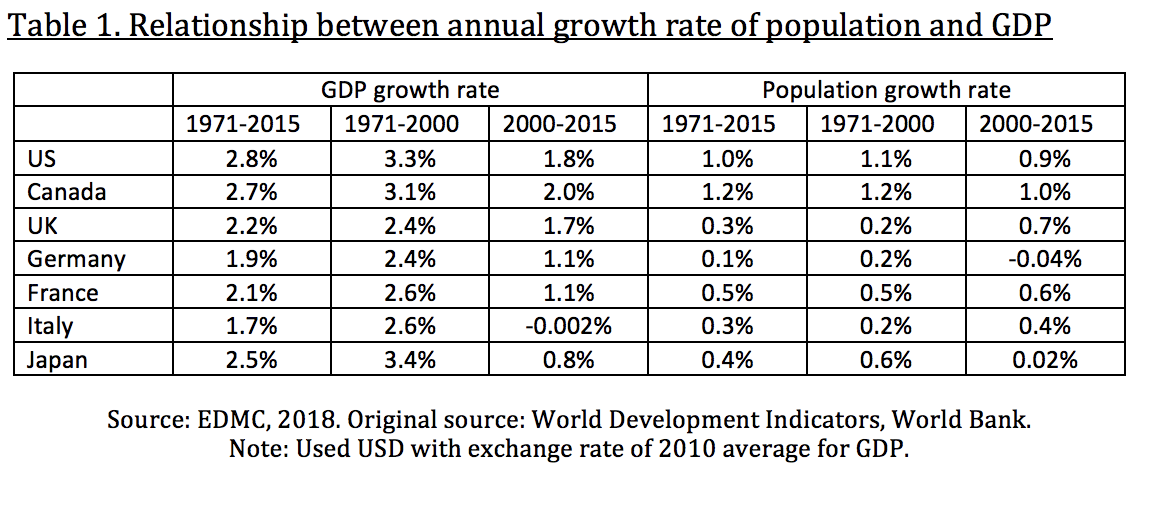
Proposal 2: It is essential to establish a scheme that quantitatively predicts future technological innovation and provides necessary information, such as timing and scale, of infrastructure investment for low-carbon society.
Rationale
- Capital investment is important for technology development and diffusion, and the evolution of technology innovation is decided depending on how to judge timing and scale of the investment. In particular, it is important to pay attention to those that do not penetrate the market sufficiently yet but need massive diffusion at an early stage in the future, such as low carbon technology. The data of CO2 emissions, energy consumption, and environmental performance of new technology cannot be derived by simply extending information on the existing technologies and the technology-introduction effects to value-chain is unclear in such case. It is difficult to make investment decisions by learning curves. In LCS, quantitative technology evaluation method, ECCC (Engineering based CO2 emission and Cost Clarification methodology) has been developed. This is a detailed study of the manufacturing process of technology from heat and material balance, building a database, and making it possible to calculate cost, energy consumption and CO2 emissions for manufacturing of low carbon technology (Fig. 4). This clarifies the cost, CO2 emissions and material kind and amount needed to introducing individual technologies into society as well as integrating various technologies in combination.
- Figure 5 shows the transition of the predicted cost value according to ECCC method (marker ’○’ in the figure) and the actual price (‘×’ in the figure) of the past solar cells. As of 1991, when the annual production of 10 MW to 100 GW for solar cell manufacturing system was evaluated, and the cost was about $ 4 per W, and it was calculated to become less than 1USD/W, by future technology,. In fact, the current price is almost the same as the previously estimated price. According to latest LCS forecasts based on technology assessment, it will be less than 40 cents in 2030. . Thus, the quantitative technology evaluation by ECCC method, can predict the technology cost before the technology penetrates in the real world, and can provide important information (timing, size) for capital investment judgment.
- Table 2 shows the estimation of the power generation cost in the case at different technological levels using the ECCC method for various low carbon technologies in Japan (LCS, 2017). As the technical level rises, the power generation cost decreases. For example, in the case of a 80% reduction in CO2 emissions, promoting the technical level of solar and storage battery systems from the 2020 level to the 2030 level is equivalent to a 1-2 trillion reduction in annual power generation cost. The market potential after future technological innovation can be calculated quantitatively, and the combination of multiple technologies can also show the way to a low carbon society and a sustainable society.
Suggestions on means to implement
- By making capital investment and management decisions to disseminate technology based on quantitative technological evaluation, which can clarify CO2 emissions, amount of material/resources used, and economics of current and future technology, it is possible to propose win-win measures leading to early low carbon reduction and economic growth.
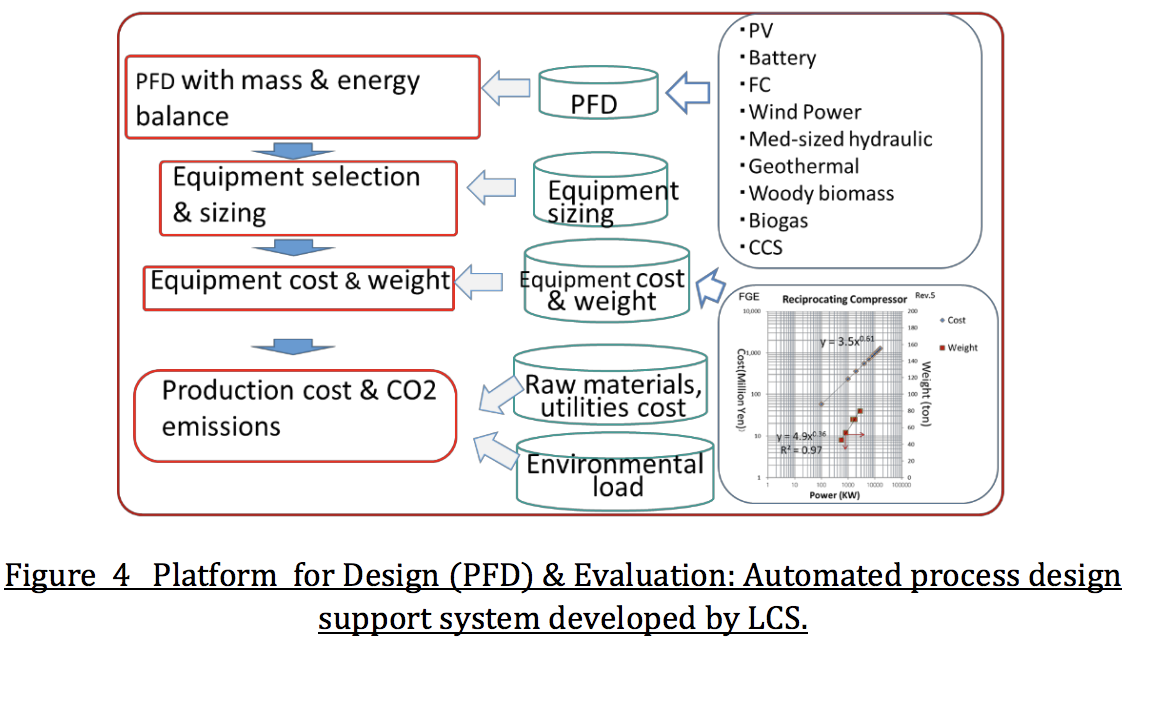
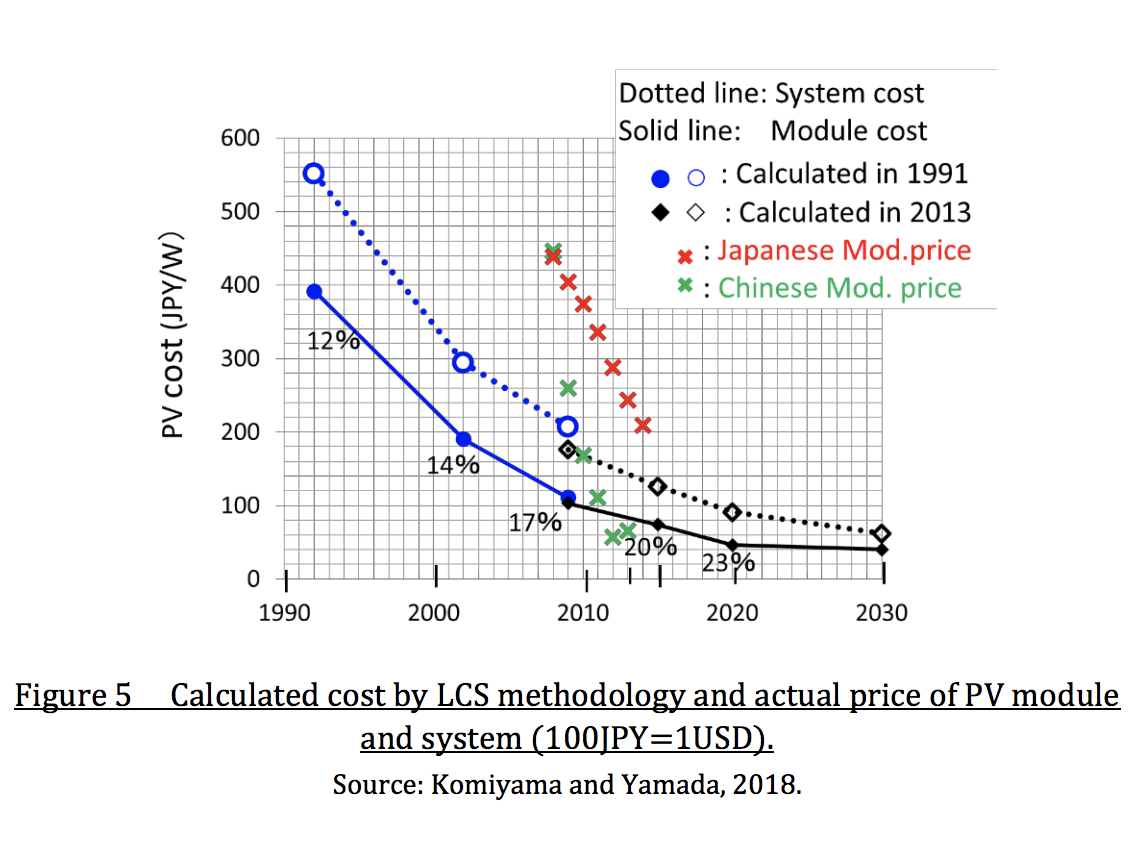
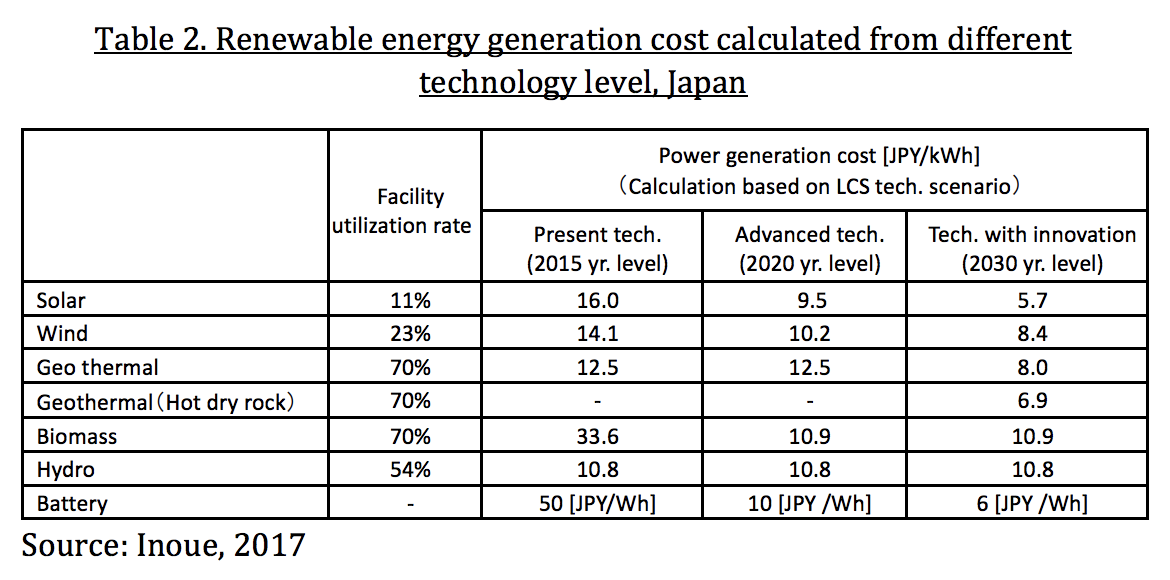
Proposal 3: It is necessary to develop and disseminate technology according to the development conditions of each country and region. For that purpose, quantitative technology evaluation should be utilized for investment judgment.
Rationale
- The introduction of a large amount of renewable energy in a future lowcarbon society creates a new energy geography. As an example to clarify this, here we take a case of the Middle East region. Tables 3 and 4 shows the power supply structure and cost of Japan and UAE for 80% reduction of CO2 in 2050, estimated by LCS with cost minimization model. It shows that UAE can achieve an 80% reduction at half cost of Japan’s case, due to the amount of available renewable resources, especially solar energy. Moreover, it is assumed that the power demand will increase from the present 100TWh to 700TWh. This amount of power is, for example, an amount that can meet the production of more than half of the world demand for producing aluminum. Thus, it is important to consider optimization of global energy use based on quantitative methodology.
- The size of the market changes with the times due to the change of social system, and it is very important to consider it properly. Depending on the degree of development, the necessary infrastructure technology is different (Figure 6). Especially after basic infrastructure development which is essential to developing countries has progressed, it is shifted to infrastructure investment that takes into consideration the environment and sustainability. It depends on how leap frogging is possible during this transition. Also, as development progresses, it becomes time to introduce advanced systems in such area of information and medical care. At this stage, aiming for higher added value economic activity, we must lead to the development of low CO2 / GDP.
Suggestions on means to implement
- In order to clarify the investment destination of low-carbon technology, it is necessary to consider the cost information by considering the regional energy situation, natural environment, etc. in a quantitative technology model.
- Making judgments for investment abroad based on reliable market size forecasts by detailed technical evaluations rather than based on current market size only, will provide sustainable scheme for donor developed countries beyond simple aiding system.
- As development progresses, appropriate intergovernmental cooperation and assistance should be promoted, and a highly value-added society will be formed to reduce CO2 emissions per economic activity.
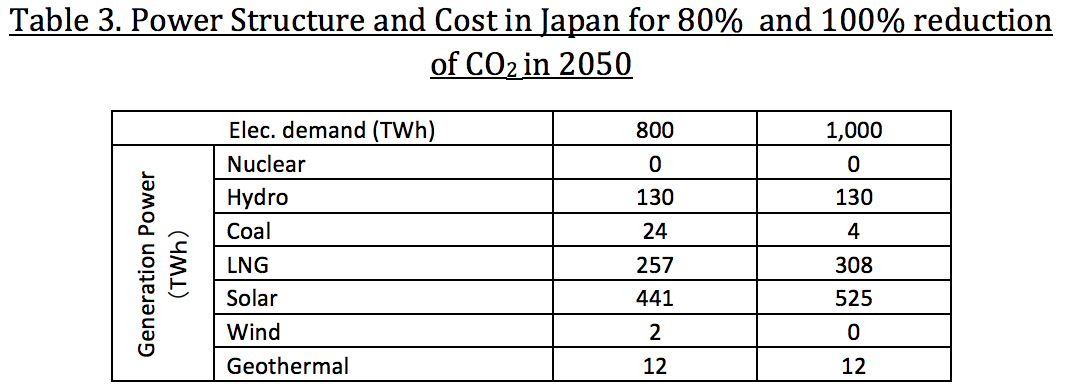

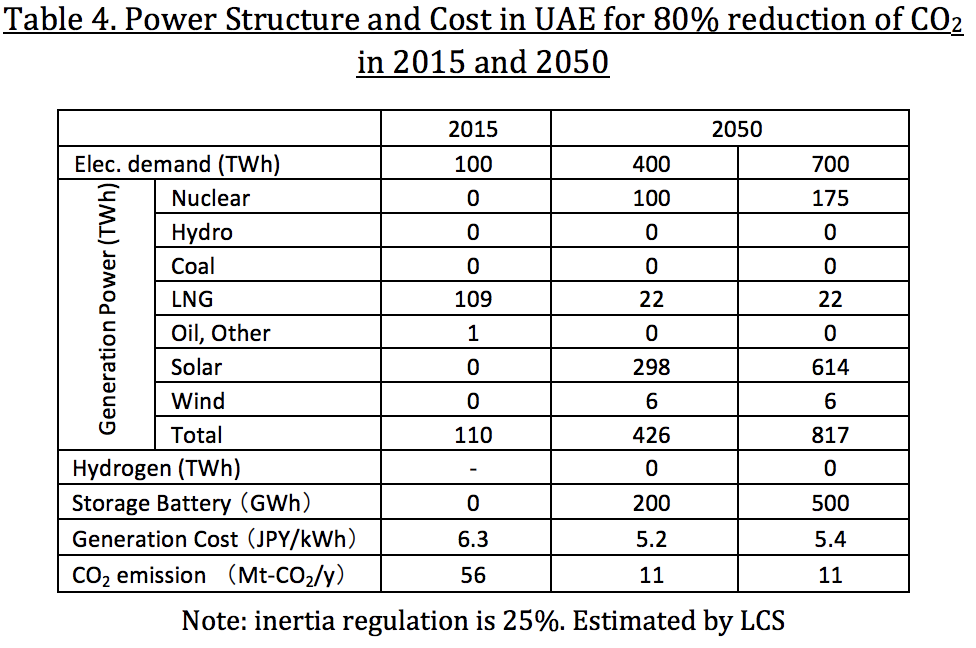
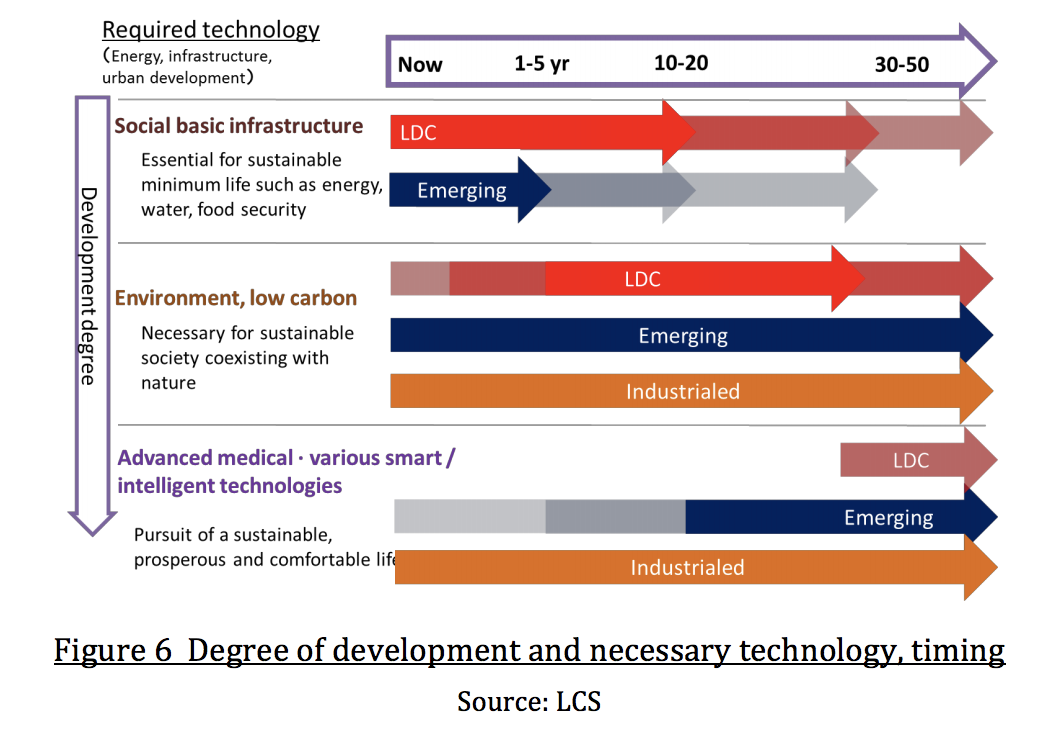
Proposal 4: From viewpoints of environment, resource and energy efficiency, further improvement and replacement of industries on a global scale is necessary in the future, and a scenario that takes into account the plans for such proper and effective international specialization is indispensable.
Rationale
- In the future society, major reforms have already been foreseen, such as decarbonization of energy and massive increase in material demand due to population and economic growth. The IPCC reported that low-carbon or zero-carbon energy becomes from three to four times of 2010 levels in 2050 at the 450 ppm scenario. In addition, large-scale use of carbon capture and storage (CCS) and bio-energy CCS (BECCS) are assumed. The demand for materials and products in the world has also been rising in the last 40 years (Figure 7), and will increase in the future, considering the future development of the world, which will also increase GHG emissions. In such a largely changing society, it is important to consider the future industrial structure, international cooperation and specialization of industry for optimal production of products and materials. The efforts include energy efficiency, carbon efficiency, material efficiency improvement at the manufacturing stage, and service utilization efficiency at the service utilization stage.
- Fig. 7 shows the correlation between GDP per capita (degree of development) and annual net domestic demand per capita of steel (= apparent consumption – indirect export + indirect import) and social stock. The higher degree of development, the higher net domestic demand (blue) and accumulated amount (orange). In developed countries, there are sufficient stocks and many countries have stabilized net domestic demand. In contrast, developing countries tend to have low stocks but high net domestic demand (blue above orange). The further development of developing countries will result that steel demand continues to increase. For example, in 2100, the world population will increase to 11.2 billion people according to UN estimate. Assuming that the world’s average of steel stock per capita is at the current level of developed countries (15 t / capita), society will need 136 billion tons of new steel by 2100. This requires virgin iron instead of scrap iron. (This corresponds to an additional emissions of about 190 billion tons of CO2). It depends on how clean this amount of new iron can be produced in the future with low carbon technology. It is clear that further efforts for global technical cooperation and low carbonization are important.
Suggestions on means to implement
- The future industrial structure will change. It is important to look at future industrial structures from the long-term social image that takes into consideration progress of innovative technologies such as IT and AI and structural change of energy supply and demand, population and labor. We should identify the basic material manufacturing industries required for social infrastructure and new low-carbon industries to be promoted that can produce high added value.
- In order to reduce carbon, resources, materials and products used on the earth are handled by international cooperation and international division of labor. Establish a framework of international partnership for that purpose.
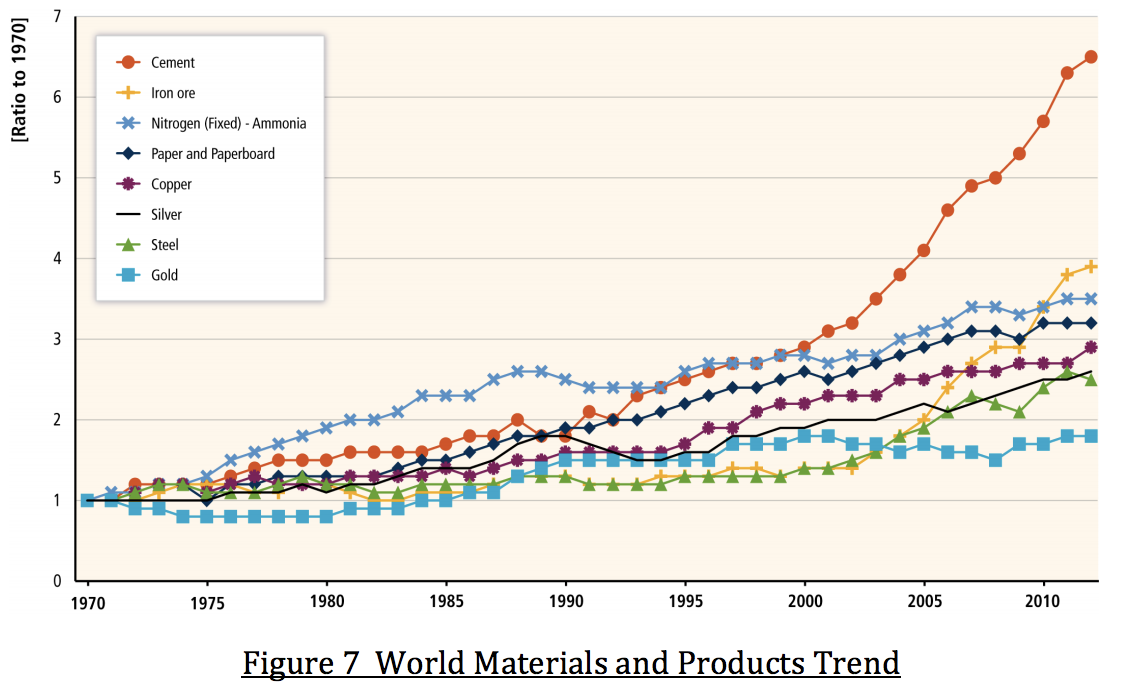

Proposal 5: Showing relationship between results of quantitative technology scenarios and evaluation methods of industrial structure change is a foothold for creating new industries with high economic benefit.
Rationale
- The model using the input-output table so far has not clarified the spillover effect when new technology is introduced into society or society is transformed. Therefore, LCS has developed a new input-output table model that enables spillover assessment using ECCC. Economic impact and total CO2 emissions when using zero carbon power source are shown in Table 5 using the new assessment model based on input-output table developed by LCS (Figure 9) (Yamada, 2019 ). It is assumed that other energy use is the same as the current situation, so decarbonizing the power supply will reduce CO2 emissions only to 63%. For further reduction, it is necessary to cover fossil fuel utilization currently consumed as thermal energy with decarbonizing power and to reduce carbon emissions from industrial processes.
- Not only decarbonization of power supply, but also social change is important. For example, by promoting tourism, advanced health care, application of electric vehicles, enhancing education and communication, high functional steel use and energy saving at residential and industry sectors (*), CO2 will be reduced to 43% and CO2 / GDP will be reduced to 0.96 g-CO2/JPY.
Suggestions on means to implement
- Efforts to decarbonization should be discussed in the overall social image, using a model that can assess what kind of spillover effects are existing in the whole industry. This makes it possible to consider the proposal of a new social system and its economy-wide impact.
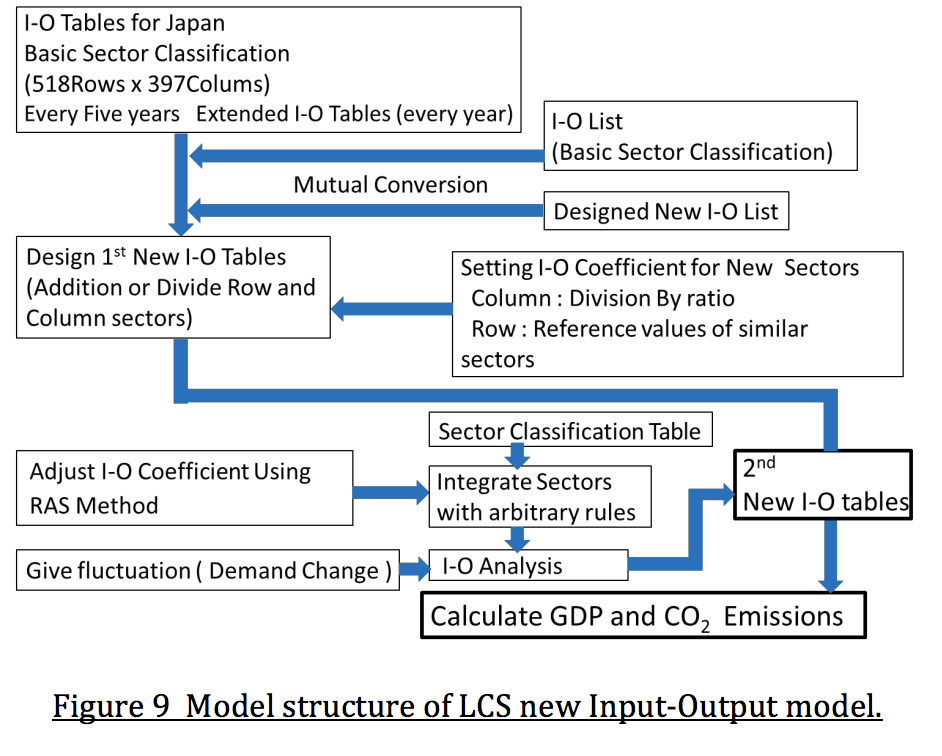
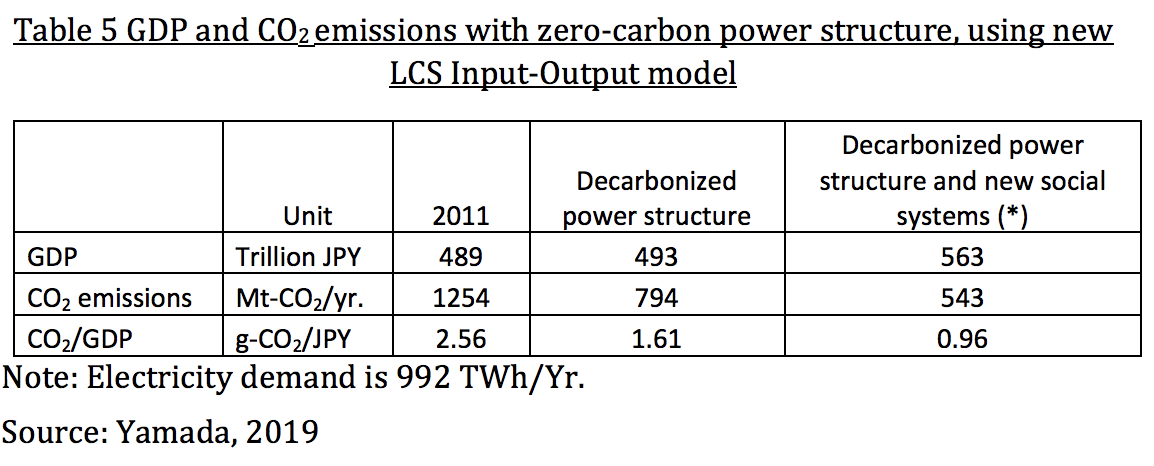
References
• Boden, T.A., G. Marland, and R. J. Andres, ‘Global, Regional, and National Fossil Fuel CO2 Emissions.’ Carbon Dioxide Information Analysis Center (CDIAC), Oak Ridge National Laboratory, U.S. Department of Energy, Oak Ridge, Tenn., U.S.A. doi 10.3334/CDIAC/00001_V2010.
• EDMC, Energy Databank, ISBN 978-4-87973-469-3, 2018
• Komiyama, H. and K. Yamada, “New Vision 2050”, Springer, 2018 https://www.springer.com/jp/book/9784431566229
• Inoue, T., “Economic Evaluation for Low Carbon Electric Power System, Considering System Stability (vol. 2): Technological Development Issues toward Zero-Emissions Electric Power Systems”, Strategy for Technology Development, Proposal Paper for Policy Making and Governmental Action toward Low Carbon Societies, Center for Low Carbon Society Strategy, Japan Science and Technology Agency, 2018.3. (https://www.jst.go.jp/lcs/pdf/fy2017-pp-14.pdf)
• Fischedick M., J. Roy, A. Abdel-Aziz, A. Acquaye, J.M. Allwood, J.-P. Ceron, Y. Geng, H. Kheshgi, A. Lanza, D. Perczyk, L. Price, E. Santalla, C. Sheinbaum, and K. Tanaka, 2014: Industry. In: Climate Change 2014: Mitigation of Climate Change. Contribution of Working Group III to the Fifth Assessment Report of the Intergovernmental Panel on Climate Change [Edenhofer, O., R. Pichs-Madruga, Y. Sokona, E. Farahani, S. Kadner, K. Seyboth, A. Adler, I. Baum, S. Brunner, P. Eickemeier, B. Kriemann, J. Savolainen, S. Schlömer, C. von Stechow, T. Zwickel and J.C. Minx (eds.)]. Cambridge University Press, Cambridge, United Kingdom and New York, NY, USA.
• Maddison, A., “Monitoring the World Economy, 1820-1992 (Development Centre Studies)”, Organization for Economic, 1995
• Matthews, H.D., N.P.Gillett, P.A. Scott, K. Zickfeld, The proportionality of global warming to cumulative
• carbon emissions, Letters, Nature, Vol 459, 11 June 2009
• Tanaka, K and S. Hayashi, “Toward Future Low-Carbon Society using Scrap Iron Recycling(Vol.2)”, Strategy for Social System, Proposal Paper for Policy Making and Governmental Action toward Low Carbon Societies, Center for Low Carbon Society Strategy, Japan Science and Technology Agency, 2019.3.
•Yamada, K., “Quantitative scenario toward zero emission power system in Japan”, 2nd German-Japanese Workshop on Renewable Energies, 5-7 July 2017, Stuttgart, Germany
• Yamada, K., “Society of 2050 Toward Zero Carbon Emissions-Industry, Energy, Power generation” presentation slide, Renewable Energy Institute Symposium “Looking ahead to 2050 Japan: Industry, Energy and Electricity Generation Towards a Decarbonized Society”, Feb 06, 2019, Tokyo, Japan. (https://www.renewableei.org/en/activities/events/20190206.php)
• UN, World Population Prospects, 2017








